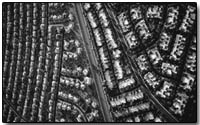|
 The
day you first set foot in a town is forever imprinted
in your memory. That moment in time becomes the benchmark
by which you measure the future. Your first glimpse kicks
off your history in that place, and as changes come along,
you reach back to it as a reference point. In the case
of Colorado, change has almost always come in the form
of growth. The
day you first set foot in a town is forever imprinted
in your memory. That moment in time becomes the benchmark
by which you measure the future. Your first glimpse kicks
off your history in that place, and as changes come along,
you reach back to it as a reference point. In the case
of Colorado, change has almost always come in the form
of growth.
I often feel like I’ve been riding the growth carousel
for the last 30 years. That topic has been one of the
only constants in my ever-changing Colorado climate. My
relationship with it began in Telluride, moved up to the
Front Range, worked its way back down to Crested Butte
and briefly stopped over again in Telluride before landing
in Durango. Sadly, the back and forth hasn’t reached
any solid conclusion.
Over the years I’ve heard all kinds of obscure
remedies – “sustainable growth,” “smart
growth,” “no growth,” “growth
paying its own way” and “inevitable growth.”
I have yet to see any of these concepts in action.
As a result, the word “growth” now carries
a sinister edge for me and others. It has assumed a distinctly,
carcinogenic flavor and become synonymous with 10,000-square-foot
homes built primarily from endangered redwood, starter
castles that are empty for all but a few weeks. It speaks
to fur coats, the jingle of gold chains and credit card
abuse. “Growth” has become emblematic of working
cattle ranches becoming stockbroker retreats. The word
conjures images of bright yellow Hummers parked in front
of Starbucks. It carries a flavor of degraded air and
water. And in general, it speaks to development run wild,
projects that looked great on paper but were eventually
built shabbily. For many, “growth” is what
fractures that first imprint.
However, in all its other forms, growth is considered
a positive experience. People speak of “personal
and spiritual growth”; children grow; and in most
cases, in most cases, the word is tied to progress.
Watching escalating property values, sitting in traffic
jams and not meeting the new Hollywood neighbors, we can
easily lose sight of the benefits. But growth also makes
for film and music festivals. It’s the stuff of
good restaurants, book stores, theater and a solid music
scene.
Growth has given Durango something other than blue collar
work. It has improved the local college, created museums
and enhanced local amenities. Growth was at least partially
responsible for the River Trail, the Durango Mountain
Park, the new fairgrounds, many of the Horse Gulch trails
and the whitewater park.
A handful of my friends grew up in Durango, and they
imprinted their first memories of this place back in the
late 1960s. All of them went out into the big world, experimented
with the other side and chose to return home.
One night when I was romanticizing to one of them about
my good-old days, he was quick to remind me that the Durango
he grew up in was little more than a large, cow town.
Growth in Durango has been more than box retailers, traffic,
housing crunches, wage crises and a real estate boom,
he told me. Instead, Durango has progressed to the point
where he’s comfortable raising a family here.
I will say that I dislike gridlock, ostentatious trophy
homes and urban attitude as much as anyone. And I have
seen rampant, relatively unchecked growth overrun two
of my homes. However, as I think about those nebulous
solutions like “sustainable development” and
“smart growth,” I see that they are aimed
at making growth a positive experience for the community
rather than the developer. With progress, it’s possible
to make that first imprint of Durango little more than
a memory, rather than something people are desperately
holding onto.
-Will Sands
|

